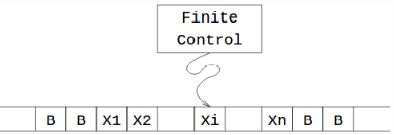Test: Programming Techniques Storage & Subroutines - Computer Science Engineering (CSE) MCQ
10 Questions MCQ Test - Test: Programming Techniques Storage & Subroutines
A turing machine has ____________ number of states in a CPU.
Suppose we have a simple computer with control unit holding a PC with a 32 bit address + Arithmetic unit holding one double length 64 bit Arithmetic Register. The number of states the finite machine will hold:
In one move a turing machine will:

Statement: We can use the finite control of turing machine to hold a finite amount of data.
Statement 1: Multitrack Turing machine.
Statement 2: Gamma is Cartesian product of a finite number of finite sets.
Which among the following is the correct option?
A multi track turing machine can described as a 6-tuple (Q, X, S, d, q0, F) where X represents:
Which of the following statements are false?
State true or false:Statement: Two track turing machine is equivalent to a standard turing machine.
Which of the following is/are not true for recursively ennumerable language?
According to Chomsky hierarchy, which of the following is adopted by Recursively Ennumerable language?














